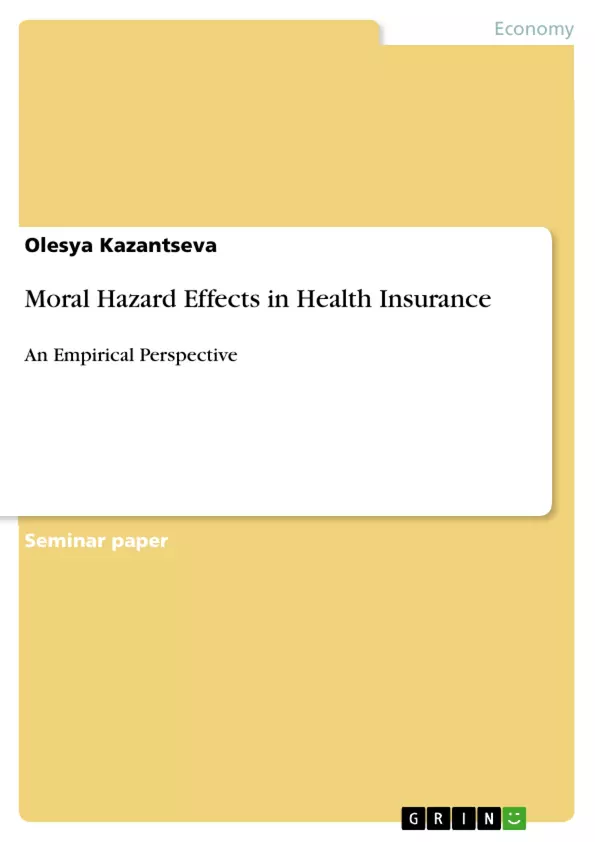Within the discussion about the increasing expenditures in health insurance, the overutilization of medical care is often attributed to the existence of a moral hazard problem. Since moral hazard has a great impact on health insurance policies, there is a growing interest in the economic literature to identify and to measure its effects. Although the problem of overconsumption of medical care does not mean moral hazard per se, the determination of the latter may reduce its scope and help to mitigate the problem of overutilization. The main objective of this paper is an empirical evidence of the moral hazard phenomenon. By analysing the economic literature on moral hazard in health insurance this paper seeks for examples of its empirical evidence, whereby the emphasis lies on distinguishing between the demand-oriented (especially ex-post) and the supply-oriented (external) moral hazard.
Table of Contents
- 1. Introduction
- 2. The phenomenon of moral hazard
Objectives and Key Themes
This paper empirically investigates the moral hazard phenomenon in health insurance. It analyzes existing economic literature to identify and measure moral hazard's effects, focusing on distinguishing between demand-oriented (ex-post) and supply-oriented (external) moral hazard. The goal is to review empirical data measuring moral hazard from these two perspectives.
- Moral hazard in health insurance
- Demand-oriented moral hazard
- Supply-oriented moral hazard
- Empirical evidence of moral hazard
- The impact of moral hazard on health insurance policies
Chapter Summaries
1. Introduction: This introductory chapter sets the stage by discussing the rising healthcare expenditures and the role of moral hazard in contributing to overutilization of medical care. It highlights the growing interest in empirically identifying and measuring moral hazard's impact on health insurance policies. The chapter emphasizes the distinction between overconsumption and moral hazard itself, noting that identifying moral hazard can help mitigate overutilization. The primary objective of the paper – providing empirical evidence of moral hazard from both demand and supply-side perspectives – is clearly stated. The structure of the paper, outlining the subsequent sections, is also presented.
2. The phenomenon of moral hazard: This chapter delves into the concept of moral hazard, tracing its origins and defining it within the context of health insurance. It uses the example of insured individuals potentially taking more risks due to the coverage provided. The chapter then explores the historical evolution of the term "moral hazard," its initial negative connotation, and its later adoption into mainstream economic literature, particularly through the work of Arrow (1963) and Pauly (1968). Arrow's focus on incomplete markets, uncertainty, and information asymmetry is discussed, along with Pauly's shift towards a more conventional economic analysis of incentives and rational behavior. The chapter concludes by summarizing key findings from Arrow and Pauly's work, emphasizing the incomplete nature of health insurance markets, the unique pricing of medical care, and the resulting overconsumption from both demand and supply sides. The ambiguous welfare implications of health insurance, balancing income transfer and individual maximization of utilization, are also highlighted. Finally, the chapter briefly touches upon different types of moral hazard, differentiating between legal and illegal forms, and distinguishing between internal (ex-ante and ex-post) and external moral hazard.
Keywords
Moral hazard, health insurance, overutilization of medical care, demand-oriented moral hazard, supply-oriented moral hazard, empirical evidence, economic analysis, healthcare expenditures, risk, incentives, information asymmetry.
Frequently Asked Questions: A Comprehensive Language Preview
What is the overall topic of this document?
This document is a comprehensive language preview of a paper that empirically investigates the moral hazard phenomenon in health insurance. It analyzes existing economic literature to identify and measure moral hazard's effects, focusing on distinguishing between demand-oriented (ex-post) and supply-oriented (external) moral hazard.
What are the key themes explored in this paper?
The key themes include moral hazard in health insurance, specifically demand-oriented and supply-oriented moral hazard, empirical evidence of moral hazard, and the impact of moral hazard on health insurance policies. The paper also delves into the historical evolution of the concept of moral hazard and its economic analysis.
What is the objective of the research presented?
The main objective is to review and present empirical data measuring moral hazard in health insurance from both demand and supply perspectives. This involves distinguishing between overconsumption and moral hazard and demonstrating how identifying moral hazard can help mitigate overutilization of healthcare.
What does the introduction chapter cover?
The introduction sets the context by discussing rising healthcare expenditures and the role of moral hazard in overutilization. It highlights the importance of empirically measuring moral hazard's impact and clarifies the distinction between overconsumption and moral hazard itself. It also outlines the paper's structure and objectives.
What is discussed in the chapter on "The phenomenon of moral hazard"?
This chapter defines moral hazard in the context of health insurance, tracing its origins and evolution in economic literature. It examines the work of Arrow (1963) and Pauly (1968), highlighting their contributions to understanding moral hazard through the lenses of incomplete markets, information asymmetry, and incentive structures. The chapter also differentiates between various types of moral hazard (legal/illegal, internal/external) and discusses the ambiguous welfare implications of health insurance.
What are the key chapter summaries provided?
The provided summaries briefly describe the content of the introduction and the chapter on the phenomenon of moral hazard. They highlight the key arguments and findings presented within each chapter.
What keywords are associated with this research?
The keywords include moral hazard, health insurance, overutilization of medical care, demand-oriented moral hazard, supply-oriented moral hazard, empirical evidence, economic analysis, healthcare expenditures, risk, incentives, and information asymmetry.
What is the intended audience for this document?
The intended audience is likely academics and researchers interested in health economics and the empirical investigation of moral hazard in health insurance.
Where can I find more information about this research?
This preview provides a summary. To access the full research paper, you would need to consult the original publication from the publishing company.
- Arbeit zitieren
- Olesya Kazantseva (Autor:in), 2014, Moral Hazard Effects in Health Insurance, München, GRIN Verlag, https://www.grin.com/document/276825



